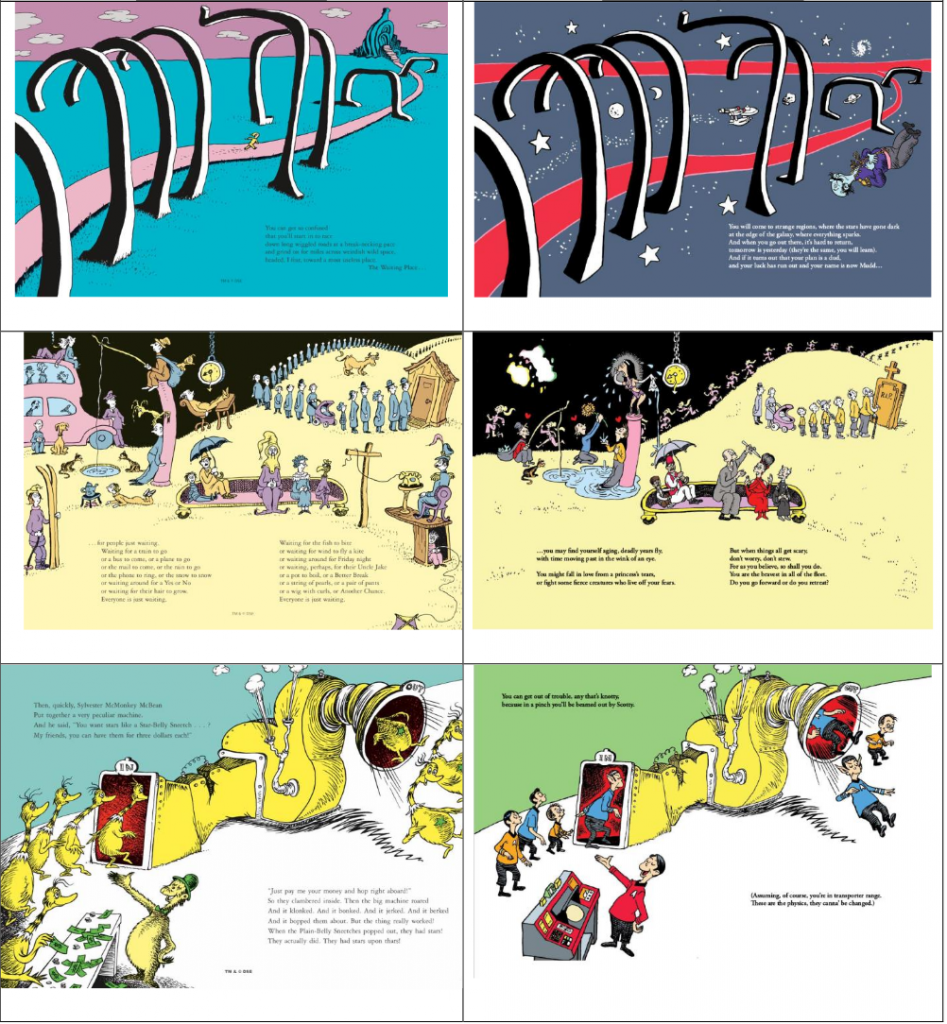
As a follow up to our recent coverage of the fair use issues in the Chronicle Books v. Audible Inc. case, Authors Alliance Copyright Research Assistant Nicolas Charest provides an update on three current cases involving the doctrine of fair use. Click on each case name below to learn more.
Oh, the Places You’ll Boldly Go! (“Boldly”) is a book that combines the use of imagery, characters, and other visual elements from the Star Trek franchise and the works of Dr. Seuss (most notably Oh, the Places You’ll Go!). In 2016, Dr. Seuss Enterprises sued the creators of Boldly, alleging that the work infringes on Dr. Seuss’ works. (The plaintiffs also brought trademark and unfair competition claims, which are not reviewed in this post.) As for the copyright claim, the defendants argued that the use was permitted under the fair use doctrine.

In March 2019, the district court held that the use of elements of Seuss’s work in Boldly is a fair use. Under the first fair use factor (the purpose and character of the use), the court found that although defendants borrowed from Dr. Seuss’ work, these elements were always adapted and the work is highly transformative, thus favoring fair use. Because Dr. Seuss’ work is highly creative, the court found that the second factor (the nature of the work), slightly favored the plaintiffs. Under the third factor (the amount and substantiality of the portion taken), the court found that because the elements are similar, but not replicated, the third factor does not weigh against the defendants. The court explained that while some shapes were borrowed, they were adapted to the Star Trek universe; for example, the narrator is transformed into Captain Kirk and instead of a Seussian landscape, the cover image is set in space. Under the fourth factor (the effect of the use on the market), the court found that the plaintiff failed to introduce evidence demonstrating that Boldly will substantially harm the market for Oh, the Places You’ll Go!, concluding that the fourth factor therefore favors neither party. Balancing all factors together, the court concluded that Boldly is a fair use of Dr. Seuss’ literary universe.
Dr. Seuss Enterprises appealed the decision, and the case is now before the US Court of Appeals for the Ninth Circuit. In its opening brief filed in August, Dr. Seuss Enterprises argues that the four factors do not lead to a finding of fair use. They argue that Boldly is not transformative since it does not parody, comment, criticize or comment on Oh, the Places You’ll Go!. They argue that the defendants “merely aped the purpose of Go!: entertaining the readers (mostly graduates starting out in the world) with an uplifting story.” They further highlight that Dr. Seuss’ works are substantially borrowed because elements central to the Seussian universes are taken, and that merely putting Star-Trek elements in what is otherwise a Seuss world does not result in any transformation. Finally, Dr. Seuss Enterprises argues that Boldly is likely to harm the market for authorized mash-ups.
Recently, the defendants filed a reply brief maintaining that Boldly makes fair use of Dr. Seuss’ books. We will follow developments in the Ninth Circuit.
In the late 1990s, Alan Wofsy, a San Francisco-based art gallery and art book publisher, published and distributed in France The Picasso Project, a catalogue containing reproduction of photographs of Pablo Picasso’s works. These photographs were taken from another catalogue initially published by Christian Zervos (the Zervos Catalogue). Yves Sicre De Frontbrune then acquired the rights into the Zervos Catalogue, and later filed a copyright infringement claim against Wofsy on the basis that The Picasso Project infringed on the copyrights over the photographs. In 2001, a judgment of copyright infringement was obtained in France against Wofsy which also ordered an “astreinte” that required the defendant to pay €10,000 for each future act of copyright infringement in the works. In 2011, copies of The Picasso Project were again found in France and De Fontbrune sought enforcement of the astreinte and consequently a French court awarded €2 million to De Fontbrune in 2012.
Recognition of the 2012 judgment in California was then sought to enforce the award of money. As part of its analysis to determine whether a foreign judgment can validly be recognized and enforced in the United States, a court must determine whether the judgment is repugnant to the public policy of the forum state or the United States. Wofsy argued that, based on the same facts in the United States, the use of the copyrighted photographs was protected by US fair use and there would be therefore no finding of copyright infringement, which would mean that the astreinte judgment issued by the French court was “repugnant” to US public policy.
The California district court analyzed the four fair use factors to assess whether a conduct constitutes fair use. The Court decided that the first (purpose and character of the use) and fourth (the effect of the use on the potential market) factors weighed strongly in favor of fair use. The Picasso Project is a reference work intended for libraries, academic institutions, art collectors, and auction houses, which demonstrates that it has an educational purpose, despite the concurrent commercial nature of the work. The Court also found that The Picasso Project and the Zervos Catalogue were destined to disparate markets and were offered at wildly different price points, Zervos being sold as high as $100,000 at auction while The Picasso Project’s volume can be purchased at $150 a piece or as a set ranging from $2,780 to $3,780. It appeared unlikely to the Court that one would ever compete against the other. The court found the second factor (the nature of the copyrighted work), to slightly disfavor fair use, because while the photographs are creative works, the goal was to faithfully reproduce Picasso’s work, not to showcase the original artistic expression of the photographer. Finally, the court found that the third factor (the amount and substantiality of the portion taken), weighs in favor of fair use because Wofsy copied less than ten percent of The Zervos Catalogue’s photographs. The court ultimately concluded that it would not recognize the 2012 judgment because The Picasso Project’s use of copyrighted photographs qualifies as fair use.
On September 12th 2019, the district court granted summary judgment in favour of Wofsy on the basis of the fair use doctrine, and partly in favour of the representatives of De Fontbrune on other procedural grounds. Both parties have appealed.
Sketchworks, an Atlanta-based sketch comedy company, wrote and produced a play titled Vape: The Musical. Vape follows the narrative arc of the hit musical Grease, but brings the cast of characters into the modern day by integrating elements such as online dating, millennial slang, and vaping. A link to the full performance can be found here.
Sketchworks performed Vape in Atlanta in 2018 with enough success to warrant a production of the play in New York, which was scheduled to open in August 2019. Prior to the show’s opening, Sketchworks received a cease-and-desist letter from the copyright holders in Grease, claiming that Vape infringes on Grease and demanding that the production immediately be stopped. Shortly after, the New York theatre cancelled the performances. On August 9th 2019, Sketchworks filed a motion for a declaratory judgment, asking a district court in New York to find that to the extent that Vape uses copyrightable elements from the play Grease, it is fair use under the exception of parody in copyright law.
Sketchworks argues that Vape is a deliberate parody of Grease that is intended to criticize its misogynistic and sexist elements, which the creators argue have not aged well. At the same time, the play is set in modern times and attempts to show that the struggles of contemporary teenagers are similar to what their Grease-counterparts experienced in their time. As stated in the complaint, “Vape not only comments on the controversial themes in Grease, it also explores whether modern society has progressed at all by pointing to current systemic issues that still exist based on the misogyny of the era in which Grease was written and is set.” Sketchworks concludes that any elements that may be copyrightable are used in a sufficiently transformative manner and are used for parody purposes which justify a finding of fair use on its play’s use, if any, of copyrightable elements borrowed from Grease.
The response to the complaint is due November 8.
__________________________________________
To learn more about fair use, we recommend taking a look at our Fair Use FAQs. Nonfiction authors can explore Authors Alliance’s Fair Use for Nonfiction Authors, a guide that helps nonfiction authors make confident fair use decisions when incorporating source materials into their writings. Other communities of creators can learn how their communities apply fair use in situations typical to their given community through best practices documents developed by those communities.
Discover more from Authors Alliance
Subscribe to get the latest posts sent to your email.
